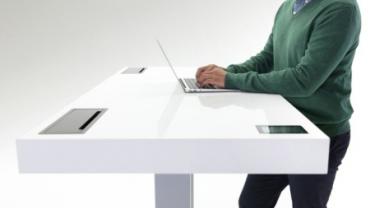
The plethora of alarmist news stories and scientific publications implicating being too sedentary is causing everything from back pain to increased risk for diabetes and heart disease would have people believe that if their chosen profession requires extended periods of time seated they’re condemned to a certain fate of chronic illness. It’s fairly well established that sitting for the vast majority of one’s time can be detrimental for health but this doesn’t mean that the opposite—standing all day—is especially beneficial. In fact being on one’s feet all day particularly when it involves extended amounts of standing in place brings negative impacts of its own.
Looked at from an ancestral health perspective our genetic heritage didn’t evolve under conditions in which our ancestors were sedentary but certainly hunting and gathering were not static activities that required long periods of standing in place. Nobody was sitting around the campsite checking their Twitter feed or commenting on friends’ Facebook statuses. On the other hand you can’t exactly chase prey or forage for edible plants if you’re standing still. Our genes have likely been conditioned to “expect”—and possibly thrive in—conditions where dynamic movement made up a significant portion of the day.
Nursing is an example of a profession that requires standing for significant portions of a shift. It also may involve heavy lifting such as with transporting medical equipment machinery and supplies. According to a survey completed by over 800 Dutch nurses 36% regularly experienced back pain and 30% and 16% experienced arm/neck and leg pain respectively. Not all of this is attributable to standing however. The subjects indicated that lifting working in awkward postures and stooping over played a significant role in their physical complaints. Aside from the obvious issues of foot leg and back pain which may result from extended time standing in the workplace standing for long periods of time may cause or exacerbate venous insufficiency although some researchers disagree.
When work absolutely requires people to be on their feet for a significant portion of the day it may be important for them to be mindful of shifting positions at regular intervals. In some cases it is not being on one’s feet per se that may cause musculoskeletal problems but rather remaining in one static position for an extended period of time. Anyone who’s stood in a long winding line at an amusement park can verify that standing in place seems to put stress on the feet and lower body in a way that the same amount of time spent walking or hiking does not. Individuals required to stand for long periods of time may benefit from consciously shifting their weight and repositioning their body. They may also benefit from similar movements of those designed to help people involved in sedentary work but with a focus on motions intended to engage the legs and feet. Simply getting the body out of the static position and intentionally contracting the muscles of the legs and feet may help circulate lymph and facilitate proper distribution of extracellular fluids thereby reducing lower body edema.
Just as an industry of treadmill desks and inflatable balls as chairs has built up around helping desk jockeys become more active during their workday ergonomic studies have led to the creation of myriad products designed to ease the strains placed on the bodies of people with physically demanding jobs. Cushioned floor mats support hose/stockings specially designed shoes and shoe inserts are all simple interventions that may help standing workers feel more comfortable and experience less fatigue.
Specific types of floor mats—sometimes referred to as “anti-fatigue mats”—have been shown to reduce lower back and leg discomfort and swelling in the lower extremities compared to standing on a hard floor. Ergonomically designed shoes and shoe insoles may also reduce subjective feelings of general fatigue and objective measurements of lower leg swelling. Uncomfortable floors are associated with fatigue and discomfort in the low back and lower leg but the effects may not be detectable until after a substantial amount of time perhaps three or more hours. With some jobs requiring employees to be on their feet for shifts of upwards of eight or more hours standing for three hours or more in the workplace is not unheard of.
Being too sedentary and standing too much both present health challenges. Going from one extreme to the other is not the solution. A sensible place for people to start restoring balance is for them to simply be aware of how much of their day they spend sitting or standing and put conscious effort into incorporating more dynamic movement into their everyday lives both in and out of the workplace.